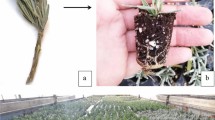Abstract
Field studies were conducted in 2006 and 2007 to investigate the reaction of 10 varieties of kenaf (Hibiscus cannabinus) to natural infestation of Meloidogyne incognita. Ten weeks after planting, 10 randomly selected plants per variety were assessed for root galling. Data were also collected on plant height, stem girth, days to maturity, number of seeds and seed yield. Gall index and nematode reproduction factor varied significantly among the kenaf varieties. AU 64 recorded the tallest height of 2.4 and 2.3 m, respectively, in 2006 and 2007 cropping seasons followed by Ex-Funtua, Ifeken 100 and G 45 whereas the lowest height was recorded for Ifeken 400 and Cuba 108. Days to maturity ranged from 120 to 135 days. Based on gall index ratings, AU 64, Ex-Shika, Ex-Giwa, G45, and the local variety were susceptible to M. incognita. Tianung 1 and Cuba 108 were very susceptible, whereas Ifeken 100 and 400 were resistant. Based on reproduction factor, AU 64, Ex-Shika, Ex-Giwa, G 45, Ex-Funtua and the local variety supported greater nematode reproduction and were good hosts of root-knot nematodes. Tianung 1 and Cuba 108 were very susceptible while Ifeken 100 was a poor host of M. incognita.
Zusammenfassung
In den Jahren 2006 und 2007 wurde die Resistenz von 10 Sorten von Kenaf (Hibiscus cannabinus; Ostindische Hanfrose, Gambohanf) gegenüber dem Wurzelgallennematoden Meloidogyne incognita im Feld überprüft. Zehn Wochen nach dem Pflanzen wurden 10 zufällig ausgewählte Pflanzen pro Sorte auf Wurzelgallen untersucht. Daneben wurden die Pflanzenhöhe, der Sprossumfang, die Zeit bis zur Vollreife, die Samenanzahl und der Samenertrag gemessen. Der Gallenindex und der Reproduktionsfaktor der Nematoden unterschieden sich deutlich zwischen den Kenafsorten. Die Sorte AU 64 erreichte mit 2,4 bzw. 2,3 m 2006 und 2007 die größte Höhe, gefolgt von den Sorten Ex-Funtua, Ifeken 100 und G 45, während die Sorten Ifeken 400 und Cuba 108 die geringsten Höhen aufwiesen. Die Zeit bis zur Vollreife variierte zwischen 120 und 135 Tagen. Anhand des Gallenindex wurden die Sorten AU 64, Ex-Shika, Ex-Giwa, G45 und eine lokale Sorte als anfällig gegenüber M. incognita bewertet. Die Sorten Tianung 1 und Cuba 108 waren hoch anfällig, während Ifeken 100 und 400 als resistent bewertet wurden. Anhand des Reproduktionsfaktors vermehrten sich die Nematoden an den Sorten AU 64, Ex-Shika, Ex-Giwa, G 45, Ex-Funtua und der lokalen Sorte schneller, weshalb sie als gute Nematodenwirte gelten können.
Similar content being viewed by others
Literature
Adamson, W.C., J.A. Martin, N.A. Minton, 1975: Reaction of kenaf and roselle on land infested with root-knot nematodes. Plant Dis. Rep. 59, 130–132.
Adeniji, M.O., 1970: Reaction of kenaf and roselle varieties to the root-knot nematode in Nigeria. Plant Dis. Rep. 54, 547–549.
Eisenback, D., H. Hirschmann, J.N. Sasser, A.C. Triantaphyllou, 1981: A guide to the four most common species of root-knot nematodes (Meloidogyne spp.) with a pictorial key. North Carolina State University Graphics, Raleigh, NC, USA.
Hussey, R.S., K.R. Baker, 1973: A comparison of methods of collecting eggs of Meloidogyne spp. including a new technique. Plant Dis. Rep. 57, 1025–1028.
McSorley, R., J.L. Parrado, 1986: Relationship between height of Kenaf and root galling by M. incognita. Nematropica 16, 205–211.
Minton, N.A., W.C. Adamson, G.A. White, 1970: Reaction of Kenaf and Roselle to three root-knot nematode species. Phytopathology 60, 1844–1845.
Sasser, J.N., C.C. Carter, K.M. Hartman, 1984: Standardization of host suitability studies and reporting of resistance to root knot nematode. North Carolina State University, Department of Plant Pathology, Raleigh, NC, USA.
Starr, J.L., L.J. Page, 1990: Nematode parasites of cotton and other tropical fibre crops In: M. Luc, R.A. Sikora, J. Bridge (eds.): Plant Parasitic Nematodes in Subtropical and Tropical Agriculture, pp. 539–556. CAB International, Wallingford, United Kingdom.
Summers, T.E., C.C. Seale, 1958: Root knot nematodes, a serious problem of Kenaf in Florida. Plant Dis. Rep. 42, 792–795.
Webber, C.L., 1996: Kenaf production, properties and potential uses. Proceedings of the International Kenaf Association Conference 8, 3–8.
Whitehead, R.H., J.R. Hemming, 1965: A comparison of some quantitative methods of extracting small vermiform nematodes from soil. Ann. Appl. Biol. 55, 25–38.
Author information
Authors and Affiliations
Corresponding author
Rights and permissions
About this article
Cite this article
Adegbite, A.A., Agbaje, G.O., Akande, M.O. et al. Expression of resistance to Meloidogyne incognita in kenaf cultivars (Hibiscus cannabinus) under field conditions. J Plant Dis Prot 115, 238–240 (2008). https://doi.org/10.1007/BF03356270
Received:
Accepted:
Published:
Issue Date:
DOI: https://doi.org/10.1007/BF03356270



